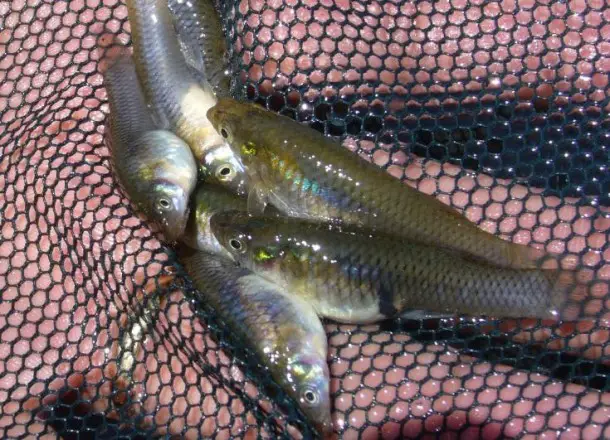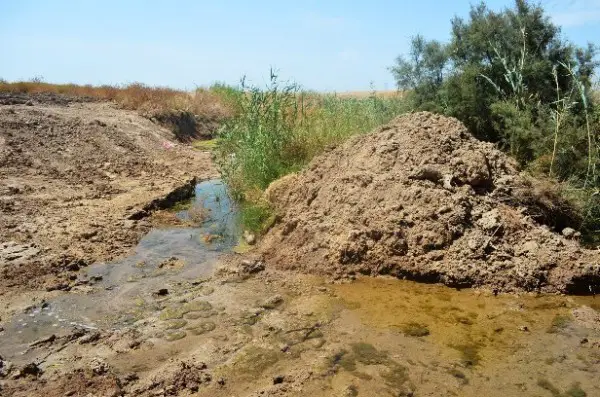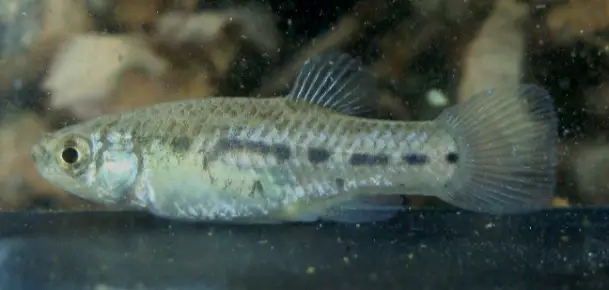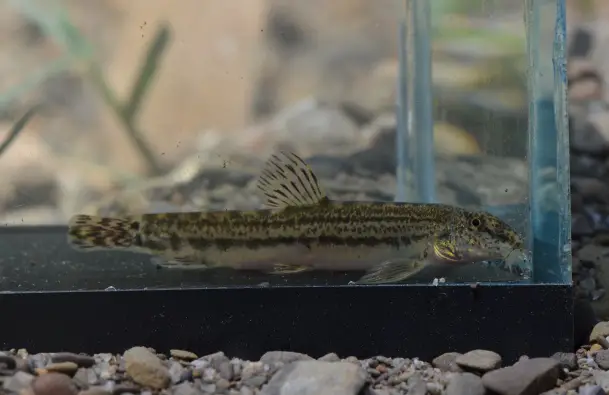Matt Ford introduces a little-known group…

Male Aphanius iberus from the Delta del Llobregat, Barcelona. © Matt Ford
The traditional image of killifishes is that of ostentatious, highly-coloured African or American species from genera such as Aphyosemion, Nothobranchius or Simpsonichthys, but it might be surprising to learn that there also exist a number of rarely-discussed, very attractive species native to Eurasia of which several are found in southern Europe.
In particular the genus Aphanius Nardo, 1827 contains more than 20 species which are probable descendants of ancient fishes inhabiting the former Tethys Sea.
They’re found throughout the Mediterranean region and Arabian Peninsula as far as Pakistan and India with this irregular pattern of distribution a result of geologic activity during the Cenozoic Era, and most remaining populations are geographically isolated from one another.

Map of populations in Spain with A. iberus (dark blue) and A. baeticus (purple).
Species diversity is highest in the eastern Mediterranean, Middle and Near East regions with Turkey a particular hot-spot, whereas the western Mediterranean is less rich with only four native species of which two, Aphanius iberus (Valenciennes, 1846) and A. baeticus Doadrio, Carmona and Fernández-Delgado, 2002, are endemic to Spain.
These two were once widespread throughout lowland, littoral habitats in the country, but in the last century their range has diminished dramatically and they currently exist only in a handful of brackish and hyper-saline coastal lagoons, salt marshes, and first order streams along the country’s Mediterranean and Atlantic coastlines.
This huge decline has been caused exclusively by human interference via the detrimental impact of introduced species such as the mosquitofish, Gambusia holbrooki, and mummichog, Fundulus heteroclitus, plus extensive habitat degradation caused by dessication and pollution of wetlands and human overpopulation of many coastal areas.

Introduced Gambusia holbrooki are highly-invasive throughout Mediterranean Spain. © Matt Ford
Both species are considered to be under extreme risk of extinction, and as a result they’ve become largely inaccessible to aquarists, are protected under Spanish and European law and illegal to collect without a near-impossible to obtain license. Despite these measures their numbers continue to dwindle on an annual basis, however.
A. iberus (Valenciennes, 1846) is the most well-distributed of the two in nature and best-known in the aquarium hobby. It originally occurred along the majority of Spain’s Mediterranean coastline from Catalonia to Almería but a 2006 study for the IUCN concluded that its numbers had decreased by as much as 50% in the previous decade and it’s been protected under Spanish and international conservation law since 1994.
The 16 remaining subpopulations are highly-fragmented in geographical terms, with a resultant lack of genetic flow. The situation is hardly aided by the indifference of the national authorities towards fish conservation in general, and even management of existing protected zones is totally inadequate.

The ‘Arroyo Mascardó’ in Sevilla province is a typical habitat of A. baeticus which has been degraded by human activity without intervention by authorities. © Matt Ford
For example the mummichog was originally restricted to a relatively small area in southern Spain but has recently been recorded around 800 km further north in the Ebro river delta, a wetland and natural park of internationally-recognised conservation significance which also happens to be saturated with invasive fish species.
A. baeticus was previously considered to be a geographic form of A. iberus and is restricted to less than a dozen localities mostly within the lower Guadalquivir River basin and along Spain’s southern Atlantic coastline.

Adult male of A. baeticus from the Río de la Vega, Andalucía. © Matt Ford
Although it looks very similar it can be told apart from A. iberus by possession of 9-11 branched anal-fin rays (vs. 8-9 in A. iberus), a noticeably shorter snout, relatively thick (vs. thin) vertical bars in males and a flank patterning consisting of a few large (vs. numerous, small) dark markings in females.
The reproductive biology of Iberian Aphanius shows adaptations typical of species inhabiting unstable environments and is characterised by early sexual maturity, a high reproductive effort and short lifespan with most individuals surviving less than a year.
Females spawn continuously between the months of April and September and can deposit over 1000 eggs over the course of the season. These are laid singly or in small batches among aquatic vegetation or filamentous algae and hatch in around 8 days.

Adult female of A. baeticus from the Río de la Vega. © Matt Ford
Sexual dimorphism in both species is pronounced with males possessing a series of steely-blue vertical bars in the posterior portion of the body, these becoming more intense in nuptial individuals.
Females are less colourful, possessing only a series of irregular dark blotches on the flanks, and larger with a maximum size of around 50 mm SL compared with 35-40 mm in males.
Aquarium breeding is not difficult but at time of writing it remains illegal to remove either species from their natural waters and the fish shown here were released immediately after being photographed.

Flank patterning of male A. baeticus (left) vs. A. iberus. © Matt Ford
Case example
I first visited the Río de la Vega in Andalucía, southern Spain while sampling several rivers in the area in late August 2008. It’s a short, first-order river rising in the mountains of the El Estrecho Natural Park, its lower reaches running alongside the coastal town of Tarifa before emptying into the Atlantic.
This area is notable for its great diversity of bird and marine life as well as its position as the southernmost point in Europe. Northern Morocco can appear to be within touching distance on a clear day and the stretch of coastline close to the town is one of the few in the south of Spain yet to have been destroyed by tourist developments.

The Río de la Vega in summer. © Matt Ford
Although there were plenty of A. baeticus here the situation initially appeared dire as the fish were surviving in what amounted to little more than a series of large puddles in the dry river bed. Worse, they were concentrated underneath a motorway bridge and directly adjacent to a new commercial development.
The pool under the bridge in particular was filthy and contained a number of aluminium cans and other refuse. Sympatric species in the pools included an Atherina species, probably A. boyeri, the invasive and highly-destructive red swamp crayfish Procambarus clarkii, two species of shrimp and the spined loach Cobitis paludica, another endangered Spanish endemic that I was very pleased to find.

The loach Cobitis paludica is another Spanish endemic inhabiting the Río de la Vega. © Matt Ford
Subsequent visits in 2009, 2010, and 2011 made for enlightening experiences since the habitat is highly seasonal in nature, so while one can walk along the dry bed for several hundred metres during summer this is impossible in autumn, winter and spring due to the beautiful, flowing river which is several metres deep in places!
During these three seasons A. baeticus can be found in both slow-moving, clear water and faster-flowing, more turbid sections of the river, but always in marginal zones with submerged grasses, filamentous algae and riparian vegetation.
It’s restricted to a freshwater stretch a few hundred metres from the sea and it’s this limited range along with the proximity of the habitat to human developments that places this population in a precarious position.

The Río de la Vega in spring. © Matt Ford
Furthermore southern Spain is in the midst of an ongoing water shortage and it’s conceivable that a couple of dry summers could eradicate the temporary pools in which the fish spend the warmer months of the year, plus the habitat is not formally protected.
Despite the gloom there are reasons for positivity, and I’m proud to be involved with the Sociedad de Estudios Ictiológicos (Society of Ichthyological Studies), one of the few groups in the country concerned with preservation of these little-known killifishes. Look out for more about them and their work in upcoming blogs and articles.
References:
Doadrio, I., J. A. Carmona and C. Fernández-Delgado, 2002. Morphometric study of the Iberian Aphanius (Actinopterygii, Cyprinodontiformes), with description of a new species. Folia Zoologica 51: 67–79
Hrbek, T. and A. Meyer, 2003. Closing of the Tethys Sea and the phylogeny of Eurasian killifishes (Cyprinodontiformes: Cyprinodontidae). Journal of Evolutionary Biology 16(1): 17-36
Oliva-Paterna, F. J., I. Doadrio. and C. Fernández-Delgado, 2006. Threatened Fishes of the World: Aphanius baeticus (Doadrio, Carmona & Fernández Delgado, 2002) (Cyprinodontidae). Environmental Biology of Fishes 75(4): 415-417
Oliva-Paterna, F., M. Torralva and C. Fernández-Delgado, 2006. Threatened Fishes of the World: Aphanius iberus (Cuvier & Valenciennes, 1846) (Cyprinodontidae). Environmental Biology of Fishes 75(3): 307-309
Wildekamp, R.H., F. Küçük, M. Ünlüsayin, and W. V. Neer, 1999. Species and Subspecies of the Genus Aphanius Nardo 1897 (Pisces: Cyprinodontidae) in Turkey. Turkish Journal of Zoology 23: 23-44
Blanco, J.L., T. Hrbek and I. Doadrio, 2006. A new species of the genus Aphanius (Nardo, 1832) (Actinopterygii, Cyprinodontidae) from Algeria. Zootaxa 1158: 39-53
















Product reviewers wanted
Are you still looking for product reviewers?
19th Dec 2024
Product reviewers wanted
Hey! Interesting article!
17th Dec 2024
Site improvements
Got it! Thanks for the update. It's good to know that Seriously Fish is working on improving the site's performance and addressing the email and forum...
21st Nov 2024
Responsive design
Nice
13th Nov 2024
Responsive design
it is a complete malfunctioning horror on iphone and ipad.
10th Nov 2024